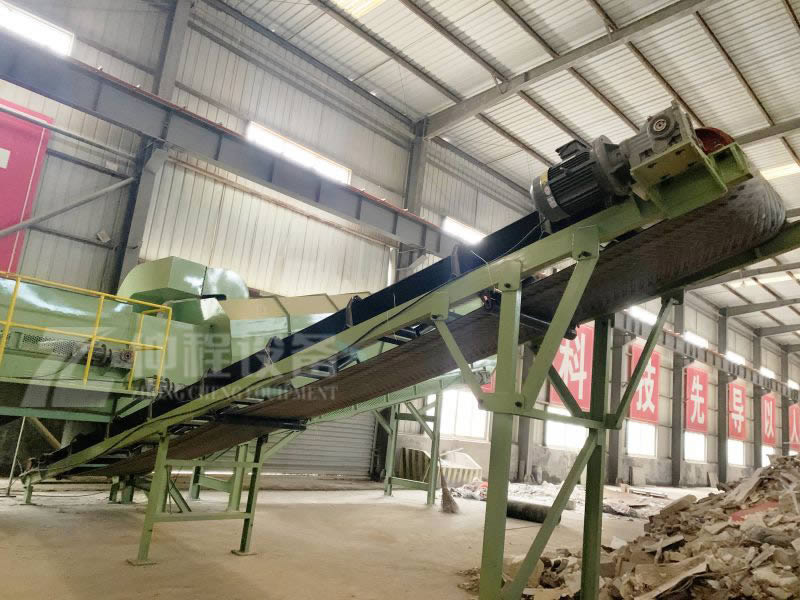Decoration waste treatment process and main equipment
Decoration garbage disposal refers to the comprehensive handling of leftover materials, tailings, and other waste generated during the decoration, repair, and beautification processes of various buildings, including wood, plastic, metal, textiles, glass, gypsum, tiles, cement, often mixed with paint, coatings, etc. Improper disposal not only leads to resource waste but also causes environmental pollution.

Zhongcheng's decoration waste treatment equipment
Decoration garbage primarily comprises six categories:
1.Old concrete, bricks, and mortar scraps These mainly stem from the renovation of non-load-bearing walls in houses.
2.Scrap metal and glass These are primarily sourced from the transformation and replacement of safety facilities, such as railings, doors, and windows.
3.Floor tiles, wall tiles, hardwood floors, wallpaper, and wall coverings These are generally waste products resulting from house decoration or renovation.
4.Timber blocks and artificial boards These mostly come from the scraps generated during the fabrication of custom-made cabinets and installation of framing members.
5.Cardboard and plastic This category mainly includes light-weight materials like various packaging bags.
6.Other hazardous waste Such as paint, coatings, adhesives/latexes, and packaging materials.
A Decoration garbage resource utilization production line is equipped with feeding machines, bouncing screens, positive pressure air classifiers, bar grizzly screens, drum screens, and crushers, among others. By employing processes such as crushing, sizing screening, density-based screening, magnetic separation, air separation, eddy current separation, and dust removal, the line can effectively sort out metal, wood, plastic, glass, non-ferrous metals, reclaimed aggregates, and RDF (Refuse-Derived Fuel), thus realizing resource recovery and recycling. This addresses the issue of environmental pollution caused by Decoration garbage and promotes the reduction, recycling, and harmless treatment of waste.
Through years of continuous practice, setbacks, and improvements, our Decoration garbage sorting process has essentially met customers' preliminary requirements for waste sorting. However, interacting with clients over the years, we've identified two misconceptions some customers have about Decoration garbage sorting:
1.Can a single sorting machine completely separate Decoration garbage? Many clients hope to achieve complete separation of Decoration garbage using a single machine. Given the current technological capabilities, it is challenging for a single piece of equipment or a single process step to deliver optimal sorting results. To process Decoration garbage effectively, a variety of sorting equipment needs to be combined into a complete production line to gradually reduce and categorize the waste.
2.Is it better to separate Decoration garbage as cleanly and finely as possible? Some clients request that we sieve Decoration garbage as cleanly and finely as possible. From a market perspective, we believe that the destination of sorted Decoration garbage should be driven by market demand; there's no necessity to overly refine the sorting process for Decoration garbage.
-
 Trommel screenTrommel screen, also known as drum screens, are widely used in various industries for sorting and separating materials.Get Quote
Trommel screenTrommel screen, also known as drum screens, are widely used in various industries for sorting and separating materials.Get Quote -
 Crop straw double shaft shreddApplications:Biomass Energy Production: Shredded straw can be used as a feedstock for bioenergy plants to produce electricity or heat.Livestock Feed: Reduced-si...Get Quote
Crop straw double shaft shreddApplications:Biomass Energy Production: Shredded straw can be used as a feedstock for bioenergy plants to produce electricity or heat.Livestock Feed: Reduced-si...Get Quote -
 Zhongcheng Air Drum SeparatorAir drum separators effectively separate lightweight materials (e.g., plastics, paper) from heavier materials (e.g., metals, glass). This high efficiency is cru...Get Quote
Zhongcheng Air Drum SeparatorAir drum separators effectively separate lightweight materials (e.g., plastics, paper) from heavier materials (e.g., metals, glass). This high efficiency is cru...Get Quote
-
2025-03-03Mini Copper Wire GranulatorThe copper wire granulator machine is a device specially used to process waste wires and cables. Its main function is to separate the copper and plastic in the ...
-
2024-05-18Mobile Jaw Crusher PlantMobile jaw crushing station is a novel rock crushing equipment, also known as mobile crushing station. The purpose of its design concept is to stand from the cu...
-
2024-07-16Drum screen garbage processing machine for msw recyclingManaging municipal solid waste (MSW) efficiently is crucial for urban areas. Drum screen garbage processing machines are a game-changer in this field. They ensu...
-
2024-06-11Optimize Your Waste Management Today with Our Advanced Drum ScreensUnderstanding the Mechanism and Optimization of Drum Screens for Waste Management
-
2024-05-18Spring Cone CrusherSpring cone crushers are generally used in the medium and fine crushing links of mine crushing, and are mainly used in the secondary crushing and tertiary crush...



